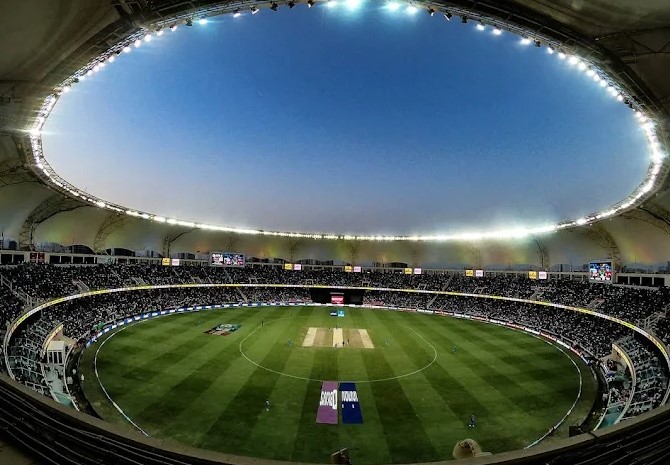E2BET: Dubai International Cricket Stadium: The Dubai International Cricket Stadium, also known as the Dubai Sports City Cricket Stadium, is one of the most iconic cricket venues in the United Arab Emirates (UAE) and has hosted numerous international and domestic matches since its inauguration in 2009. One of the crucial elements influencing gameplay in cricket is the boundary length, which can affect batting strategies, bowling tactics, and even match outcomes.
This article explores the boundary dimensions of the Dubai International Cricket Stadium in detail, providing measurements, comparisons, and the impact of the ground’s size on match play.
Overview of Dubai International Cricket Stadium
| Feature | Detail |
|---|---|
| Location | Dubai Sports City, Dubai, UAE |
| Established | 2009 |
| Seating Capacity | Approx. 25,000 (expandable to 30,000) |
| Floodlights | Yes (Ring of Fire technology) |
| First International Match | 2009 |
| Pitch Type | Typically batting-friendly, can vary |
Boundary Length Measurements
Unlike some cricket grounds with fixed boundary distances, the boundary lengths at the Dubai International Cricket Stadium can vary slightly depending on the pitch location on the square and match setup. However, the general range of boundary distances is consistent within certain limits.
Average Boundary Dimensions
| Direction | Distance (Approx.) |
|---|---|
| Straight Boundaries | 75–80 meters |
| Square Boundaries | 65–70 meters |
| Long-on/Long-off | 72–78 meters |
| Third Man/Fine Leg | 60–65 meters |
ICC Regulations
According to ICC regulations, the minimum boundary length in international cricket should be no less than 59.43 meters (65 yards) from the center of the pitch. Dubai adheres to these standards, and in most matches, the boundaries are set well beyond this minimum.
Ground Shape and Layout Impact
The stadium is oval-shaped, and due to the flexibility of the square (the 22-yard pitch can be relocated across the central playing square), boundary lengths vary from match to match. This adaptability means teams need to assess the exact ground dimensions on match day to optimize their game plan.
| Pitch Positioning | Effect on Boundaries |
|---|---|
| Central pitch | Balanced boundaries on all sides |
| Pitch shifted to offside | Longer leg-side, shorter offside |
| Pitch shifted to leg-side | Longer offside, shorter leg-side |
| Closer to straight boundary | Extended square boundaries |
Impact of Boundary Size on Match Play
Batting Strategies
- Short square boundaries often encourage aggressive horizontal-bat shots like sweeps, pulls, and cuts.
- Long straight boundaries require more power and timing for sixes down the ground, promoting grounded strokes.
- Batsmen often adapt based on boundary dimensions, particularly in T20 formats where maximizing runs per delivery is crucial.
Bowling Strategies
- Spinners benefit from longer boundaries, especially square of the wicket, as mishits often fall short.
- Pacers may employ fuller lengths and yorkers more often when the straight boundary is longer, aiming to reduce scoring zones.
Notable Records Influenced by Boundaries
| Match | Record/Event | Impact of Boundaries |
|---|---|---|
| India vs Pakistan, Asia Cup 2022 | Last-over thriller | Moderate boundaries allowed controlled hitting |
| IPL Matches (various seasons) | Several high scores (200+ totals) | Short square boundaries aided big scoring |
| PSL Finals | Close finishes | Balanced dimensions tested team strategies |
Comparison With Other Grounds
| Stadium | Average Boundary Length (Straight/Square) |
|---|---|
| Dubai International Cricket Stadium | 75–80m / 65–70m |
| Sharjah Cricket Stadium | 60–65m / 55–60m |
| Sheikh Zayed Stadium, Abu Dhabi | 78–82m / 68–72m |
| MCG (Australia) | 85–90m / 80–85m |
Conclusion
The boundary lengths at the Dubai International Cricket Stadium play a crucial role in shaping the nature of the game. Whether it’s an explosive T20 encounter, a calculated ODI match, or a Test session under lights, the size and layout of the boundaries influence every ball bowled and shot played. Balanced in design and adhering to international standards, Dubai offers a fair yet challenging environment for cricketers from around the globe.
As cricket continues to evolve in the UAE, the Dubai stadium remains a central figure—not just for its modern facilities and spectacular lighting, but also for the subtle tactical nuances it introduces through its well-structured boundaries.


